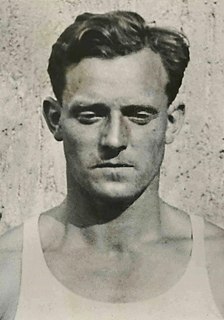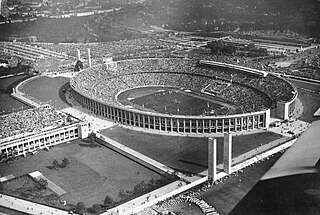 W
WAt the 1936 Summer Olympics in Berlin, 29 athletics events were contested, 23 for men and 6 for women. The program of events was unchanged from the previous Games. There was a total of 776 participants from 43 countries competing.
 W
WThe men's 110 metres hurdles event at the 1936 Summer Olympic Games took place on August 5 and August 6. Thirty-one athletes from 20 nations competed. The maximum number of athletes per nation had been set at 3 since the 1930 Olympic Congress. The final was won by American Forrest Towns. It was the second of nine consecutive American victories, and the eighth overall gold medal for the United States in the 110 metres hurdles. Don Finlay of Great Britain became the second man to win two medals in the event.
 W
WThe men's 200 metres sprint event at the 1936 Olympic Games took place between August 4 and August 5. There were 44 athletes from 22 nations competing. The maximum number of athletes per nation had been set at 3 since the 1930 Olympic Congress. The final was won by African American Jesse Owens, with silver going to Mack Robinson. Owens thus reached 3 gold medals in 1936, with the sprint relay still to come. The Netherlands earned its first medal in the men's 200 metres with Tinus Osendarp's bronze.
 W
WThe men's 400 metres hurdles event at the 1936 Summer Olympic Games took place on August 3 and August 4. There were 32 competitors from 20 nations. The maximum number of athletes per nation had been set at 3 since the 1930 Olympic Congress. The final was won by American Glenn Hardin. After two Games of silver and bronze medals, it was the United States' first victory since 1920 and sixth overall. However, it was the first time since 1900 that the Americans had only one medalist in the event. John Loaring took Canada's first 400 metres hurdles medal since 1900 with his silver. Miguel White gave the Philippines a bronze in its 400 metres hurdles debut.
 W
WThe men's 1500 metres event at the 1936 Olympic Games took place August 4 and August 6. Forty-three athletes from 27 nations competed. The maximum number of athletes per nation had been set at 3 since the 1930 Olympic Congress. The final was won by Kiwi Jack Lovelock in world record time. It was New Zealand's first medal in the 1500 metres. Glenn Cunningham's silver put the United States on the 1500 metres podium for the first time since 1920. Luigi Beccali did not successfully defend his 1932 gold, but took bronze to become the first man to win two medals in the event.
 W
WThe men's 3000 metres steeplechase event at the 1936 Summer Olympic Games took place August 3 and August 8. The final was won by Volmari Iso-Hollo of Finland.
 W
WThe men's discus throw event was part of the track and field athletics programme at the 1936 Summer Olympics. The competition was held on August 5, 1936. Thirty-one athletes from 17 nations competed. The maximum number of athletes per nation had been set at 3 since the 1930 Olympic Congress. The final was won by Ken Carpenter of the United States. It was the nation's fourth consecutive, and seventh overall, victory in the men's discus throw; it was also the second consecutive Games that the Americans finished with both of the top two places, as Gordon Dunn took silver. Giorgio Oberweger earned Italy's first men's discus throw medal with his bronze.
 W
WThe men's hammer throw event was part of the track and field athletics programme at the 1936 Summer Olympics. The competition was held on August 3, 1936. There were 27 competitors from 16 nations. The maximum number of athletes per nation had been set at 3 since the 1930 Olympic Congress. The final was won by Karl Hein of Germany. The silver medal went to Erwin Blask, also of Germany. They were the first medals for Germany in the event; Germany was also the first country other than the United States to have two medalists in the event in the same Games. Fred Warngård of Sweden took bronze. The United States' eight-Games medal streak in the hammer throw was snapped, with the Americans' best result being William Rowe's fifth place.
 W
WThe men's high jump event was part of the track and field athletics programme at the 1936 Summer Olympics. The competition was held on August 2, 1936. Forty athletes from 24 nations competed. The maximum number of athletes per nation had been set at 3 since the 1930 Olympic Congress. The final was won by Cornelius Johnson of the United States. It was the nation's ninth victory in the men's high jump. Johnson's fellow Americans Dave Albritton and Delos Thurber took silver and bronze to complete the podium sweep, the second time the United States had taken all three medals in the event.
 W
WThe men's long jump event was part of the track and field athletics programme at the 1936 Summer Olympics. The competition was held on August 4, 1936. Forty-three athletes from 27 nations competed. The maximum number of athletes per nation had been set at 3 since the 1930 Olympic Congress. The final was won by American Jesse Owens. It was the United States' fourth consecutive and ninth overall gold medal in the event; it was also Owens's second of four gold medals in the 1936 Games. Luz Long won Germany's first medal in the event with silver; Naoto Tajima put Japan on the podium for the second Games in a row with bronze.
 W
WThe men's marathon event at the 1936 Summer Olympic Games took place August 9. Fifty-six athletes from 27 nations competed. The maximum number of athletes per nation had been set at 3 since the 1930 Olympic Congress. The race was won by Sohn Kee-chung, a Korean athlete competing for Japan; Sohn refused to acknowledge the Japanese anthem at the victory ceremony. Sohn was the first Korean athlete to win an Olympic gold medal, though the medal remains credited as Japans first victory in the Olympic marathon. Finland (barely) missed the marathon podium for the first time since World War I, with its top two runners placing 4th and 5th.
 W
WThe men's pole vault event was part of the track and field athletics programme at the 1936 Summer Olympics. The competition was held on August 5, 1936. Thirty athletes from 21 nations competed. The maximum number of athletes per nation had been set at 3 since the 1930 Olympic Congress. The final was won by Earle Meadows of the United States. It was the nation's tenth consecutive victory in the men's pole vault.
 W
WThe men's shot put event was part of the track and field athletics programme at the 1936 Summer Olympics. The competition was held on 2 August 1936. Twenty-two athletes from 14 nations competed. The maximum number of athletes per nation had been set at 3 since the 1930 Olympic Congress. The final was won by Hans Woellke of Germany. It was Germany's first victory in the men's shot put, and first medal since bronze in 1928. Germany also received bronze in 1936, with Gerhard Stöck finishing third. Between the two Germans was Sulo Bärlund of Finland with silver, the nation's first medal in the event since gold in 1920. For the first time, the United States won no medals in the men's shot put, with the three Americans finishing 4th, 5th, and 6th.
 W
WThe men's triple jump event was part of the track and field athletics programme at the 1936 Summer Olympics. The competition was held on August 6, 1936. Thirty-one athletes from 19 nations competed. The maximum number of athletes per nation had been set at 3 since the 1930 Olympic Congress. The final was won by Naoto Tajima of Japan with a world-record jump. It was Japan's third consecutive gold medal in the men's triple jump; as of the 2016 Games, it is the last gold medal Japan has won in the event. Masao Harada's silver medal made it the second Games in which Japan put two men on the podium in the event. Jack Metcalfe of Australia earned bronze, Australia's first medal in the event since 1924.
 W
WThe women's 80 metres hurdles event at the 1936 Summer Olympic Games took place August 5 and August 6. The final was won by Italian Ondina Valla.
 W
WThe women's 100 metres sprint event at the 1936 Olympic Games took place between August 3 and August 4. The final was won by American Helen Stephens.